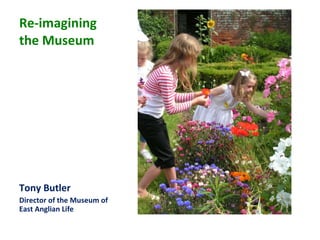Re imagining the museum
- 1. Re-imagining the Museum Tony Butler Director of the Museum of East Anglian Life
- 2. Resilience Happiness Social Enterprise Flow Social Capital Co-operation Transition Assets Participation Trust Rallying points
- 3. Ėý
- 4. Ėý
- 5. Ėý
- 6. Ėý
- 7. Ėý
- 8. Ėý
- 9. For a community to function and be sustainable, the basic needs of its residents must be met. A socially sustainable community must have the ability to maintain and build on its own resources and have the resiliency to prevent and/or address problems in the future. To be effective and sustainable, both individual and community resources need to be developed and used within the context of four guiding principles - equity, social inclusion and interaction, security, and adaptability. Vancouver City Council 2005
- 10. Characteristics of resilience Carnegie UK Trust
- 11. 1. People (human capital) Carnegie UK Trust
- 12. 2. Culture (cultural capital) Carnegie UK Trust
- 13. 3. Systems (built/natural capital) Carnegie UK Trust
- 14. 4. Links (Bridging & Linking Social Capital; Political capital) Carnegie UK Trust
- 15. Characteristics of resilience Carnegie UK Trust
- 16. Asset-Based Community Development âĶ takes as its starting point the existing assets and strengths of community, particularly the strengths inherent in community based associations and other social networks. It defines assets not just as physical capital assets such as buildings but the distinctive qualities of the environment and the skills of people within the community. Mathie, A., & Cunningham, G. ( 2003),
- 17. Ėý
- 18. Letting people define for themselves whatâs special about a place, and what matters about it... Thatâs the key. Government agencies and large bodies canât stand this. They want to define things; they want to keep tabs... only ordinary people can make ordinary places matter Sue Clifford, Common Ground
- 19. Our principles
- 20. Ėý
- 21. Ėý
- 22. Ėý
- 23. Ėý
- 24. Ėý
- 25. Ėý
- 26. Ėý
- 27. Ėý
- 28. Ėý
- 29. Ėý
- 30. What makes people happy ?
- 31. For every ÂĢ1 invested we gain over ÂĢ4 of social value Valuing and encouraging happiness and emotional investment Joint local approaches to progression Hidden value of family outcomes Key investment in cultural heritage
- 32. Ėý
- 33. Co-production The home base of the economy is the household, the neighbourhood, the community and civil society. That is the economy that co-production seems to rebuild and to reconstruct. Edgar S Cahn 2006
- 34. Ėý
- 35. Public policy can more easily remove misery than augment happiness. Happiness (2007) Richard Layard
- 36. Positive Psychology Positive Emotion The Pleasant Life Eudaemonic Flow The Good Life Using your strengths to create something greater than you are The Meaningful Life We would spend less time treating mental illness if we spend more time promoting mental wellness. Martin Seligman
- 37. Ėý
- 38. Ėý
- 39. Ėý
- 40. Ėý
- 41. Ėý
- 42. Ėý
- 43. Ėý
- 44. Ėý
- 45. [email_address] 01449 612229 www.eastanglianlife.org.uk Twitter tonybutler1 Blog http://tonybutler1.wordpress.com
Editor's Notes
- #46: Iâve worked in museums since 1997, which I think co-incides with what could be described as the good times for culture. It was a a time when expansion and growth were unprecedented. Our major towns and cities have a slew of new, beautifully designed and inspiring museums. These new museums and the policy of free admission have inspired increasing numbers of people to enjoy arts and their heritage. But this kind of exponential growth canât go on forever. The current financial crisis has shown the limits of growth. A desire for growth has skewed the way people who work in culture think. By proving our contributes to the economic potential of a locality or the country as a whole, we get more money, with more money we can do more stuff for more people. This is fine to a point but I think it has created a rigid, mechanistic mindset in the practice of museum people. We spend much time trying to prove to treasury for the next CSR or our local authority next round of budget setting, that culture can contribute to objectives in a range of areas from reducing crime to improving educational attainment, to improving health and contributing to economic regeneration. Whilst this may be true, for me this approach has taken much of the joy out of our work. We may be culturally richer than ever before but are we happier. I think our efforts should be less geared to producing more cultural stuff and but should concentrate on the happiness of our people be they, visitors, contributors, staff or volunteers. We often pride ourselves in putting people at the heart of the museum â we should put the museum in the hearts of our people. This is the way to build the social capital which is the keystone to the resilient and sustainable communities of the future.













































![[email_address] 01449 612229 www.eastanglianlife.org.uk Twitter tonybutler1 Blog http://tonybutler1.wordpress.com](https://image.slidesharecdn.com/re-imaginingthemuseum-110916022418-phpapp02/85/Re-imagining-the-museum-45-320.jpg)